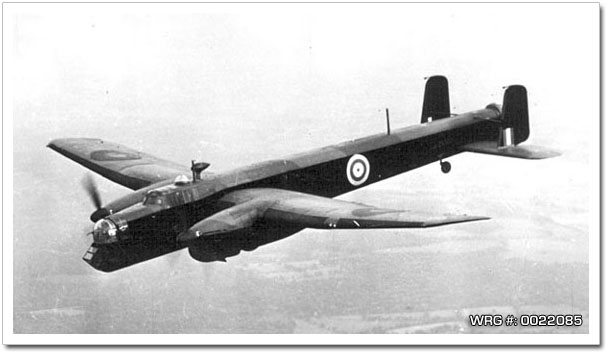BRITISH AVIATION RESOURCE CENTER > BOMBERS > WHITLEY > PREVIOUS PAGE
Design and Development
Carrying a crew of five, the Whitley was the first aircraft accepted by the RAF to have a monocoque fuselage. The project, now given the company code AW.38, was designed with a slab-sided structure and the mid-mounted wings were set at a high angle of incidence (8.5°) to provide improved take-off and landing performance. Initially flaps were omitted by later on the design was modified to include them. The design and placement of the wings gave the AW.38 a distinct "nose-down" attitude when flying straight and level, unfortunaely resulting in considerable drag.

The first aircraft of this design to fly was the Whitley Mk. I (K4586), which took to the air from Baginton airfield on March 17, 1936. Piloted by Alan Campbell-Orde, Armstrong Whitworth's chief test pilot, K4586 was powered by two Armstrong Siddeley Tiger IX radial engines providing 795hp each. The second prototype flew with Armstrong Siddeley Tiger XI radials.
In 1935, with war looming on the horizon, the RAF felt the urgent need to replace its fleet of aging biplane heavy bombers. Thus an order for 80 Whitley Mk. Is were ordered straight "off the drawing board" before the first prototype had flown. The first 34 aircraft were fitted with the Armstrong Siddeley Tiger IX engine. The next aircraft were fitted with the Tiger VIII, with a two-stage supercharger and were considered more reliable. These aircraft were designated as Whitley Mk IIs and 46 aircraft were built in this configuration, fulfilling the initial RAF order.
The addition of a retractable two gun ventral turret and the replacement of the manually operated nose turret with a powered turret in a Whitley II test aircraft, K7243, led to the Whitley Mk. III.
In 1938 the Whitley was fitted with Rolls-Royce Merlin engines, resulting in the Whitley Mk. IV. Additional modifications and minor upgrades led to the Whitley Mk. V. These modifications included leading edge de-icing equipment on the wings, modification of the tail, and replacing the manual tail turret and ventral turret with powered models with four .303 Browning machine guns. The tail was also lengthened to improve the field of fire for the tail gunner. The Whiley Mk. V was the most numerous version of the Whitley with 1,466 being built. Production ended in June 1943.

Armstrong Whitworth factory showing Whitley Mk.V bombers being constructed, 1941.
Sources:
Gunston, Bill - The Encyclodepia of the Worlds Combat aircraft, 1976, Chartwell Books, Inc., New York
Green, William - War Planes Of The Second World War - Fighters - Vol. 2, 1961, Hanover House, New York
Wikipedia
BRITISH AVIATION RESOURCE CENTER > BOMBERS > WHITLEY > PREVIOUS PAGE
